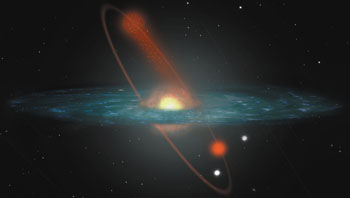Edited by Emma Sanders
ESO update
The first 8.2 m telescope of the Very Large Telescope array opens to astronomers on 1 April. It has already made interesting discoveries during its commisioning stage.

Observations of one of the star clusters orbiting the central region of our galaxy has revealed a surprisingly small number of lightweight stars. This unusual mass distribution is caused by the gravitational attraction of the Milky Way,
which pulls stars into its halo a kind of giant galactic plughole. This is the first time that the effect has been observed,
and the results can be used to obtain information about the formation of our galaxy and the amount of dark matter in its halo.
Meanwhile,
new equipment has been installed at ESO’s other observatory at La Silla. FEROS (Fibre-fed Extended Range Optical Spectrograph) was used to measure the spectra of stars in the outer galaxy.
One star was found to contain an unexpectedly large amount of lithium. This is interesting to cosmologists because lithium is the heaviest element created in measurable quantities after the Big Bang,
heavier elements being created by nucleosynthesis in stars.
A star of this age and kind would normally have lost lithium. The excess is a mystery,
which astronomers may have to wait for the VLT to solve.
New light is shed on an old problem
For the first time,
astronomers have recorded a gamma-ray burst at optical wavelengths. This is no mean feat. Although the bursts are extremely strong (up to 100 billion times as bright as ordinary stars),
they occur without warning and last for typically a few seconds. Previous optical detection has been limited to images of the fading burst.
On 23 January,
detectors onboard NASA’s Compton Gamma Ray Observatory detected the beginnings of an intense burst. Immediately,
the co-ordinates were forwarded to ground-based observatories around the world. Just 22 s later,
astronomers at a small optical telescope at Los Alamos were on target. Slower off the mark,
the mighty 10 m Keck II telescope at Mauna Kea in Hawaii later pinpointed the fading burst and measured its distance to be around 9 billion light years.
The cause of gamma-ray bursts is a mystery. Candidates include merging black holes and hypernovae massive exploding stars. The optical observations give astronomers a new insight into the processes at work.
Hear more next month at the Supernovae and Gamma Ray Burst Symposium at the Hubble Space Telescope Science Institute.





